Starting from:
$12.95
Home
World War II
World War II American Propaganda Leaflets, Psychological Warfare Manuals, and Documents - Download
World War II American Propaganda Leaflets, Psychological Warfare Manuals, and Documents - Download
World War II : American Propaganda Leaflets, Psychological Warfare Manuals & Documents
1,220 pages of American World War II propaganda leaflets and documents concerning the use of psychological warfare propaganda leaflets in the Pacific theater during World War II, copied from material held at the United States Naval Academy Archives, the Marine Corps Training & Education Command Library, and the U.S. Army Command and General Staff College library.
Japanese and Korean language material includes English translations.
The collection also includes an additional 10 Japanese propaganda leaflets targeted to Allied personnel.
This collection contains 730 leaflet images and 490 pages of supporting documents about the leaflets and the use of leaflets in psychological warfare.
World War II saw psychological warfare become a significant part of a military campaign. In a report produced by the Propaganda and Psychological Warfare Section of the United States Pacific Fleet and Pacific Ocean Areas (CINCPAC-CINCPOA), propaganda is defined as, "an organized influencing of the actions and thoughts of others by the medium of words and ideas. Applied to assault and combat operations, it is a systematized effort to influence the actions of enemy personnel in such a way as to render more successful our present and future military operations. Its purpose is to shorten the war and to save lives. Its immediate result should be the decreased resistance of enemy forces and the ultimate surrender of individuals or groups within the enemy ranks."
In the United States the Office of War Information (OWI) was created for homeland morale building and to encourage behaviors beneficial to the war effort. Common subject matters in the material for domestic consumption included participation in materiel drives, the patriotic act of buying war bonds, the recruitment of women for labor in war production, the promotion of conservation of resources, and the prompting of alertness for foreign spies. These themes were conveyed through posters, radio broadcasts, and information supplied to media outlets.
When the audience was the enemy a different goal was set. The OWI established the Psychological Warfare Branch (PWB) to produce radio and print propaganda campaigns to demoralize enemy soldiers and to discourage civilians from supporting, at least on the inside, nations of the Axis alliance.
In conjunction with branches of the armed forces, the OWI orchestrated large scale information and propaganda campaigns during World War II. Printed material and radio broadcasts were the primary medium of psychological warfare conducted by the OWI. The use of leaflets gained acceptance during World War II. According to Allan Winkler, author of "The Politics of Propaganda: The Office of War Information, 1942-1945," the PWB dropped 180 million leaflets in the Pacific, almost 100 million during the last three month of the war with Japan.
Several goals are prominent and frequent in leaflets used by The United States in the Pacific theater: To counteract enemy propaganda that Americans treat prisoners brutally; To destroy morale and induce surrender by indicating the extent to which American forces had advanced in the Pacific; To stir up pangs of homesickness and resentment toward officers and the leaders of Japan; To convince Japanese troops of the hopelessness of their situation; To induce the Japanese to surrender by promising humane treatment and by citing past instances as proof of this claim; To weaken Japanese resistance by emphasizing American military and industrial strength.
Documents in this set include:
Psychological Warfare Part 1 & Part 2
These two 1944 reports were published by the United States Pacific Fleet and Pacific Ocean Areas, CINCPAC-CINCPOA, they cover the general principles, means and methods used to deploy propaganda in the Pacific Theatre. The reports examine combat propaganda geared toward the goal of taking prisoners. They also discuss assault propaganda, propaganda directed to by-passed and isolated garrisons, themes and appeals to be used in propaganda, and the proper dissemination of propaganda. The material includes actual plans for the distribution of the leaflets.
The reports emphasize certain guidelines for the creation of the content for the leaflets. For example it is pointed out that no reference should be made to the Emperor. Instruction is given that the word kosan or kofuku (surrender) nor the word horyo or furyo (prisoner of war) should be used in leaflets geared to get Japanese soldiers to surrender.
Part 2 shows examples of leaflets used. Each entry contains an explanation sheet covering the leaflet's purpose, format, English translation, and comments about its content.
Psychological Warfare Part 2, Supplement Number 2
CINCPAC-CINCPOA bulletin no. 164-45, 15 August 1945, contains additional samples of leaflets. It contains psychological warfare leaflets which were distributed after the two reports listed above were published.
Leaflet News Letters
228 pages composed of 8 issues of "Leaflet News Letter" created by the Intelligence and Leaflet Unit, Area III, dating from April 6, 1945 to September 1, 1945.
Produced on typewriters and reproduced on mimeograph machines, this newsletter was created for overseas military personnel working in the field of psychological warfare and the distribution and writing of leaflets mostly in the Far East.
Topics repeatedly addressed include, results of recent leaflet operations, notes on leaflet writing, and the use of prisoners of war in leaflet production. Article titles include: Psychological Warfare and the Airman, Treatment of the Emperors Meiji and Taisho, and the "Moderates," Leaflet Writing Handbook for Beginners Only, Leaflet Operations by 8th Air Force Between D-Day and 1 Feb. 1945, Reasons Why Japanese Soldiers Accept or Reject Allied Propaganda, and Leaflets on Okinawa.
LEAFLET SERIAL NUMBER 401

This 6 inch by 9 inch leaflet shows an American bomber headed directly to homeland Japan. The leaflet was designed to weaken Japanese resistance prior to an American assault upon their positions. The illustrated theme conveys the message that not only is local resistance on outlying islands futile, but that even Japan is no longer safe from attacks by American bombers. The reverse side contains the following message in Japanese:
"Since our new giant bombers began their frequent air raids against Japan proper in June and our Navy and Marines captured Saipan, Tinian, and Guam, your leaders at home have been fearful lest Japan itself be invaded and seized. In a radio broadcast, for example, one of your leaders stated: 'Our forces on the coast must keep watch and prevent the landing within our defenses by enemy paratroops.'
Resistance on your part is futile. You cannot withstand the overwhelming force of our men, ships, planes, tanks, and various other weapons of war. You cannot match our amazing industrial strength. For Japan the war is already lost."
LEAFLET SERIAL NUMBER 2013

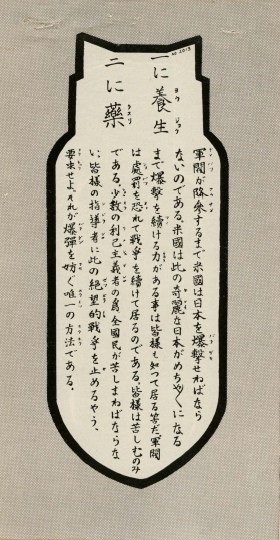
This leaflet, featuring an American bomb, is of a similar theme to the leaflet above, except its targeted Japanese civilians, not soldiers.
To convince Japanese civilians to abandon the idea of resisting American forces, the leaflet presents a well-known Japanese proverb as a device to argue that it is better to prevent the destruction of homeland Japan than to continue resistance until the nation is destroyed. The reverse of the leaflet contains this message in Japanese:
"These bombings will continue until your militarist leaders give up. You know we have the strength to continue until your beautiful land is laid in ruins. The militarists are continuing the war because they are afraid of punishment. You are the ones who suffer. The whole nation suffers to satisfy a few selfish men. Force your leaders to bring an end to a hopeless war. That is the best prevention against bombing."
LEAFLET SERIAL NUMBER 2093
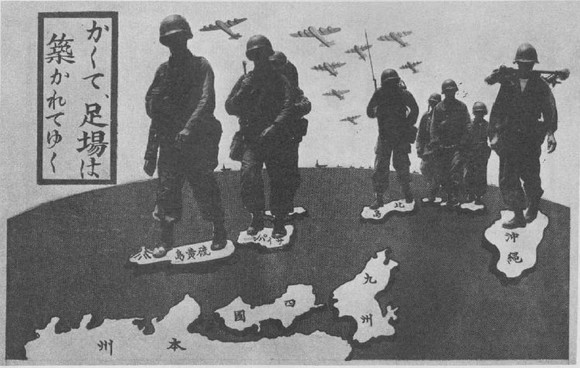
This leaflet was prepared for Japanese civilians. It contains the message on the reverse in Japanese:
"On SAIPAN, 26,000 Japanese soldiers suffered honorable defeat. On IWO JIMA 23,000 Japanese officers and men died a tragic death. In the PHILIPPINES, more than 410,000 Japanese warriors are dead. And on OKINAWA, which fell on 21 June, a total of 105,000 officers and men in the Japanese forces perished in battle.
The Japanese armed forces, which rely upon spiritual strength, can in no way compete with the Americans whose material combat strength is inexhaustible. Moreover, it would not do for the American armed forces, no matter how sorry for the people of Japan, to allow the war to end so long as the Japanese forces, who by their policy of aggression and lust of conquest have plunged mankind into the horrors of war, are not made to cry, 'We surrender!'
The Americans will therefore relentlessly carry out the invasion of the Japanese homeland. Already the island of OKINAWA has been transformed into a great base for bombing of the homeland, but enlargement of its facilities still exceeds space. There the world's greatest air bases, the combined lengths of whose taxiways total 400 miles, near completion. A foothold for American landings on JAPAN has been secured. The resolute carrying out of the campaign is only a matter of time.
Those American heroes who already have beaten Germany in the European theater are all going to press closely in upon you. The depths of the misery into which your country will then be plunged by the fearsome destructive power of modern warfare cannot be fathomed. Will your militarists, your government, then stubbornly compel you to continue resistance to the bitter end? If so, your country cannot but be totally destroyed! Beautiful Japan, the land of the gods, wherein the cherry blossoms flower, cannot then but be utterly ruined, becoming the bier of a hundred million souls!
But there is a way to escape annihilation and destruction, and that, it goes without saying, is for you to oust the military and seek rapprochement of the American forces.
We are Americans whose motto is humanitarianism. We believe we have even greater love of mankind than do you Japanese. Therefore, if you put away the sword, our forces will joyfully cooperate in the rebuilding of a democratic Japan."
Pages from reports on use of leaflets
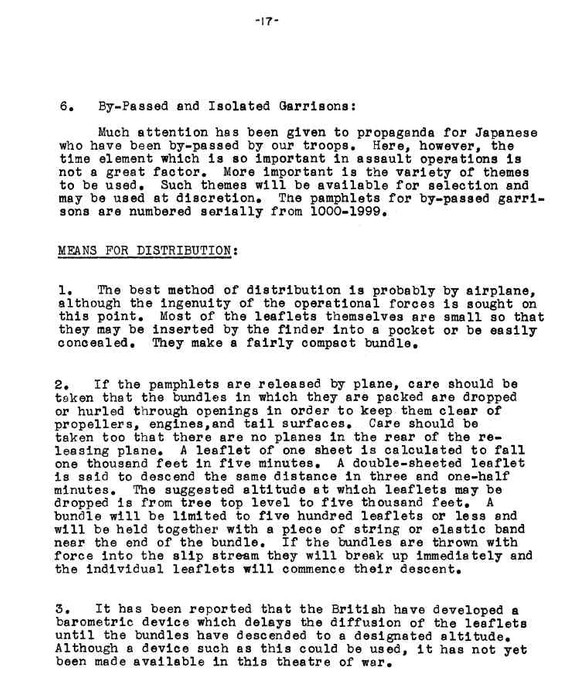
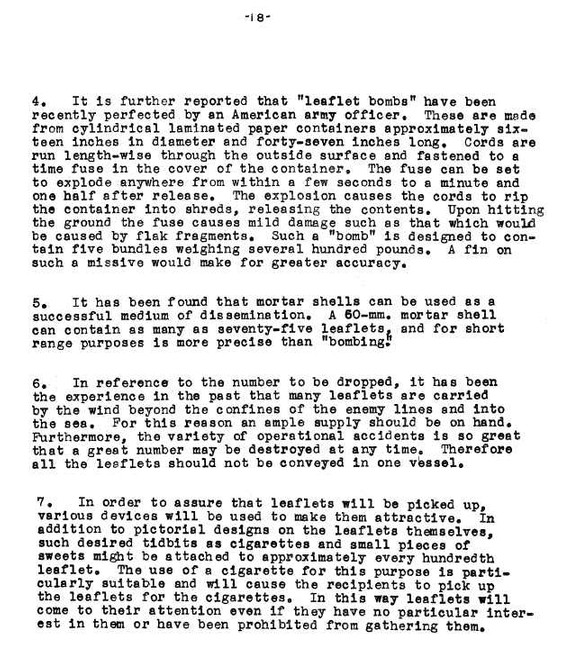
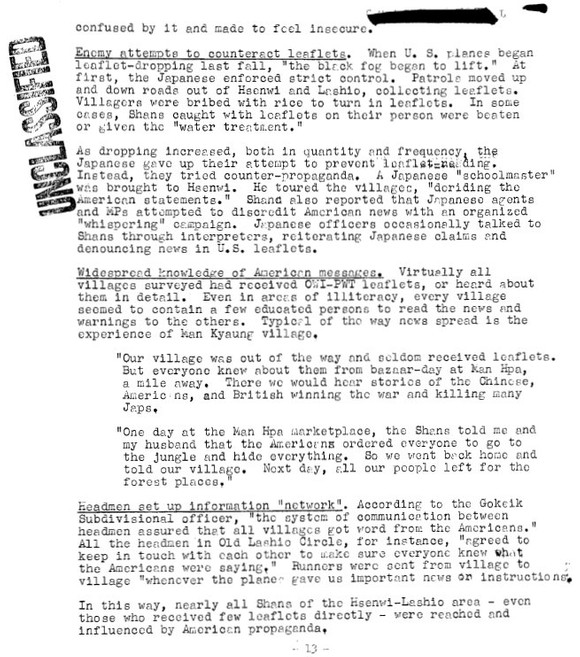
1,220 pages of American World War II propaganda leaflets and documents concerning the use of psychological warfare propaganda leaflets in the Pacific theater during World War II, copied from material held at the United States Naval Academy Archives, the Marine Corps Training & Education Command Library, and the U.S. Army Command and General Staff College library.
Japanese and Korean language material includes English translations.
The collection also includes an additional 10 Japanese propaganda leaflets targeted to Allied personnel.
This collection contains 730 leaflet images and 490 pages of supporting documents about the leaflets and the use of leaflets in psychological warfare.
World War II saw psychological warfare become a significant part of a military campaign. In a report produced by the Propaganda and Psychological Warfare Section of the United States Pacific Fleet and Pacific Ocean Areas (CINCPAC-CINCPOA), propaganda is defined as, "an organized influencing of the actions and thoughts of others by the medium of words and ideas. Applied to assault and combat operations, it is a systematized effort to influence the actions of enemy personnel in such a way as to render more successful our present and future military operations. Its purpose is to shorten the war and to save lives. Its immediate result should be the decreased resistance of enemy forces and the ultimate surrender of individuals or groups within the enemy ranks."
In the United States the Office of War Information (OWI) was created for homeland morale building and to encourage behaviors beneficial to the war effort. Common subject matters in the material for domestic consumption included participation in materiel drives, the patriotic act of buying war bonds, the recruitment of women for labor in war production, the promotion of conservation of resources, and the prompting of alertness for foreign spies. These themes were conveyed through posters, radio broadcasts, and information supplied to media outlets.
When the audience was the enemy a different goal was set. The OWI established the Psychological Warfare Branch (PWB) to produce radio and print propaganda campaigns to demoralize enemy soldiers and to discourage civilians from supporting, at least on the inside, nations of the Axis alliance.
In conjunction with branches of the armed forces, the OWI orchestrated large scale information and propaganda campaigns during World War II. Printed material and radio broadcasts were the primary medium of psychological warfare conducted by the OWI. The use of leaflets gained acceptance during World War II. According to Allan Winkler, author of "The Politics of Propaganda: The Office of War Information, 1942-1945," the PWB dropped 180 million leaflets in the Pacific, almost 100 million during the last three month of the war with Japan.
Several goals are prominent and frequent in leaflets used by The United States in the Pacific theater: To counteract enemy propaganda that Americans treat prisoners brutally; To destroy morale and induce surrender by indicating the extent to which American forces had advanced in the Pacific; To stir up pangs of homesickness and resentment toward officers and the leaders of Japan; To convince Japanese troops of the hopelessness of their situation; To induce the Japanese to surrender by promising humane treatment and by citing past instances as proof of this claim; To weaken Japanese resistance by emphasizing American military and industrial strength.
Documents in this set include:
Psychological Warfare Part 1 & Part 2
These two 1944 reports were published by the United States Pacific Fleet and Pacific Ocean Areas, CINCPAC-CINCPOA, they cover the general principles, means and methods used to deploy propaganda in the Pacific Theatre. The reports examine combat propaganda geared toward the goal of taking prisoners. They also discuss assault propaganda, propaganda directed to by-passed and isolated garrisons, themes and appeals to be used in propaganda, and the proper dissemination of propaganda. The material includes actual plans for the distribution of the leaflets.
The reports emphasize certain guidelines for the creation of the content for the leaflets. For example it is pointed out that no reference should be made to the Emperor. Instruction is given that the word kosan or kofuku (surrender) nor the word horyo or furyo (prisoner of war) should be used in leaflets geared to get Japanese soldiers to surrender.
Part 2 shows examples of leaflets used. Each entry contains an explanation sheet covering the leaflet's purpose, format, English translation, and comments about its content.
Psychological Warfare Part 2, Supplement Number 2
CINCPAC-CINCPOA bulletin no. 164-45, 15 August 1945, contains additional samples of leaflets. It contains psychological warfare leaflets which were distributed after the two reports listed above were published.
Leaflet News Letters
228 pages composed of 8 issues of "Leaflet News Letter" created by the Intelligence and Leaflet Unit, Area III, dating from April 6, 1945 to September 1, 1945.
Produced on typewriters and reproduced on mimeograph machines, this newsletter was created for overseas military personnel working in the field of psychological warfare and the distribution and writing of leaflets mostly in the Far East.
Topics repeatedly addressed include, results of recent leaflet operations, notes on leaflet writing, and the use of prisoners of war in leaflet production. Article titles include: Psychological Warfare and the Airman, Treatment of the Emperors Meiji and Taisho, and the "Moderates," Leaflet Writing Handbook for Beginners Only, Leaflet Operations by 8th Air Force Between D-Day and 1 Feb. 1945, Reasons Why Japanese Soldiers Accept or Reject Allied Propaganda, and Leaflets on Okinawa.
LEAFLET SERIAL NUMBER 401

This 6 inch by 9 inch leaflet shows an American bomber headed directly to homeland Japan. The leaflet was designed to weaken Japanese resistance prior to an American assault upon their positions. The illustrated theme conveys the message that not only is local resistance on outlying islands futile, but that even Japan is no longer safe from attacks by American bombers. The reverse side contains the following message in Japanese:
"Since our new giant bombers began their frequent air raids against Japan proper in June and our Navy and Marines captured Saipan, Tinian, and Guam, your leaders at home have been fearful lest Japan itself be invaded and seized. In a radio broadcast, for example, one of your leaders stated: 'Our forces on the coast must keep watch and prevent the landing within our defenses by enemy paratroops.'
Resistance on your part is futile. You cannot withstand the overwhelming force of our men, ships, planes, tanks, and various other weapons of war. You cannot match our amazing industrial strength. For Japan the war is already lost."
LEAFLET SERIAL NUMBER 2013


This leaflet, featuring an American bomb, is of a similar theme to the leaflet above, except its targeted Japanese civilians, not soldiers.
To convince Japanese civilians to abandon the idea of resisting American forces, the leaflet presents a well-known Japanese proverb as a device to argue that it is better to prevent the destruction of homeland Japan than to continue resistance until the nation is destroyed. The reverse of the leaflet contains this message in Japanese:
"These bombings will continue until your militarist leaders give up. You know we have the strength to continue until your beautiful land is laid in ruins. The militarists are continuing the war because they are afraid of punishment. You are the ones who suffer. The whole nation suffers to satisfy a few selfish men. Force your leaders to bring an end to a hopeless war. That is the best prevention against bombing."
LEAFLET SERIAL NUMBER 2093

This leaflet was prepared for Japanese civilians. It contains the message on the reverse in Japanese:
"On SAIPAN, 26,000 Japanese soldiers suffered honorable defeat. On IWO JIMA 23,000 Japanese officers and men died a tragic death. In the PHILIPPINES, more than 410,000 Japanese warriors are dead. And on OKINAWA, which fell on 21 June, a total of 105,000 officers and men in the Japanese forces perished in battle.
The Japanese armed forces, which rely upon spiritual strength, can in no way compete with the Americans whose material combat strength is inexhaustible. Moreover, it would not do for the American armed forces, no matter how sorry for the people of Japan, to allow the war to end so long as the Japanese forces, who by their policy of aggression and lust of conquest have plunged mankind into the horrors of war, are not made to cry, 'We surrender!'
The Americans will therefore relentlessly carry out the invasion of the Japanese homeland. Already the island of OKINAWA has been transformed into a great base for bombing of the homeland, but enlargement of its facilities still exceeds space. There the world's greatest air bases, the combined lengths of whose taxiways total 400 miles, near completion. A foothold for American landings on JAPAN has been secured. The resolute carrying out of the campaign is only a matter of time.
Those American heroes who already have beaten Germany in the European theater are all going to press closely in upon you. The depths of the misery into which your country will then be plunged by the fearsome destructive power of modern warfare cannot be fathomed. Will your militarists, your government, then stubbornly compel you to continue resistance to the bitter end? If so, your country cannot but be totally destroyed! Beautiful Japan, the land of the gods, wherein the cherry blossoms flower, cannot then but be utterly ruined, becoming the bier of a hundred million souls!
But there is a way to escape annihilation and destruction, and that, it goes without saying, is for you to oust the military and seek rapprochement of the American forces.
We are Americans whose motto is humanitarianism. We believe we have even greater love of mankind than do you Japanese. Therefore, if you put away the sword, our forces will joyfully cooperate in the rebuilding of a democratic Japan."
Pages from reports on use of leaflets



1 file (342.9MB)



